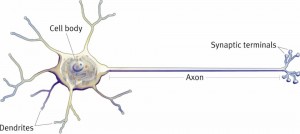Neural Networks and Machine Learning
In pursuit of building an intelligent systems, Computer scientists have tried to model the neural network and architecture of the human brain for decades. The human brain has billions of neurons inter-connected forming this giant network that gives rise to the general/adaptable intelligence, consciousness and many more attributes human beings posses. Neurons ,which are the basic component of the brain network, are modeled artificially and abstractly in a computer to what is known as artificial neurons. There are few varieties of artificial neurons, from which the so called Sigmoid neurons shows good promise in building intelligent systems.
Sigmoid neurons, models natural neurons very closely. Sigmoid neurons, similar to natural neurons, have numerous inputs and and few output that can be copied or distributed to many other neurons in the network. The figure below illustrates the similarity. 
The artificial neuron takes inputs x1,x2,…,xn and returns an output Y. All inputs and outputs are numbers between 0 and 1. Each neuron is dedicated to some simple decision; it gather the inputs x1..xn, weights each inputs with w1,w2…wn, respectively, sums them and outputs a value. The weight factors are important to weight important inputs more in the sum than not so important ones. This sum output passes through an activation function or transfer function to produce the output Y. The transfer function adds more flexibility to the output, for instance we can discretize the output by setting a threshold transfer function. Moreover, a bias is added to the sum in order to bias and turn on or off, the whole neuron when needed. This gives the flexibility to remove a neuron from a vast network without having to set each of the weighing factors of the a neuron’s inputs. More accurate graphical representation of the neuron is shown below.
The output Y can be connected and distributed to many other neurons to form a complex network such as the brain’s, as shown in the example below.
This neural network can learn to perform tasks, this is what is called Machine Learning. The network can be programmed in a way that it doesn’t need a programmer to respond to new data, to evolve and learn. The programmer sets up a case where there is a feedback of the output when trying to perform some task. Such a system then gets trained on training data, for which the optimal outcome is already known. The neural network then searches for weighing factors to each of the input of each neuron so that the output is similar to the known optimal output from the training data. It then can be fed new data, on which it can execute in the manner of the weighting factors and summation discussed above. Moreover, it can learn from this new data, and adjust and tweak the weight factors of each neuron when the outcome can be inferred/predicted to a good degree from pervious experiences.
Given the potential of such methodology, there are many interesting questions one can ask. As the interconnections and number of neurons increases will the system of neurons or machine become highly and generally intelligent? Each neuron is making a small decision in the networks which cascades to other neurons and finally outputs a major decision. Could the neural network at any point become conscious? One definition of consciousness is the ability to simulate and have a sense self. Exposed to enough data similar to that of the environment humans evolved in, can the machine find the evolutionary need and develop a sense self? And by running billions of tests and training data in a few seconds, can it learn faster than humans, and may be obtain super-intelligence? All of these capabilities will be encoded in the weighting factors and arrangements of inputs of each neurons. Arrangements, weighting factors and architecture that programmers couldn’t hard code, arrangements and weighting factors tuned by experience and training.
Some source:
http://neuralnetworksanddeeplearning.com/chap1.html



